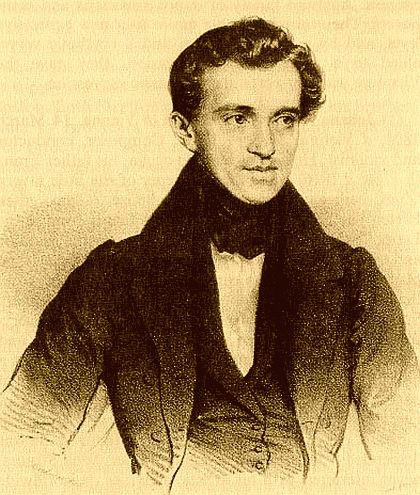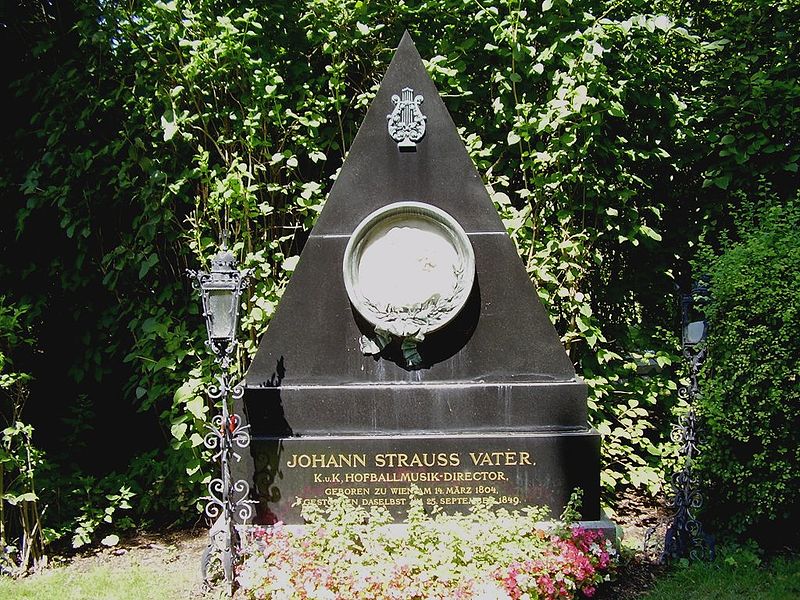<Back to Index>
- Physicist Albert Einstein, 1879
- Composer Johann Strauss, Sr., 1804
- King of Italy Vittorio Emmanuele II, 1820


Johann Strauss I (March 14, 1804 – September 25, 1849; German: Johann Baptist Strauß, Johann Strauss (Vater); also Johann Baptist Strauss, Johann Strauss, Sr., Johann Strauss the Elder), born in Vienna, was an Austrian Romantic composer famous for his waltzes, and for popularizing them alongside Joseph Lanner, thereby setting the foundations for his sons to carry on his musical dynasty. His most famous piece is probably the Radetzky March (named after Joseph Radetzky von Radetz), while his most famous waltz is probably the Lorelei Rheinklänge op. 154.
Johann Strauss was the father of Johann Strauss II, Josef Strauss and Eduard Strauss, who had a son called Johann Strauss III, born in 1866. He also had two daughters, Anna, who was born in 1829, and Therese, who was born in 1831. His youngest son, Ferdinand, born in 1834, lived only ten months. Strauss's parents, Franz Borgias Strauss and Barbara Dollmann, were innkeepers (Zum heiligen Florian). Strauss had a Hungarian Jewish grandfather, Johann Michael Strauss, who converted to Catholicism.
Tragedy struck his family as his mother died of 'creeping fever' when he was seven. When he was 12, his father Franz Borgias Strauss was discovered drowned, possibly by suicide, in the Danube river. His guardian, the tailor Anton Müller, placed him as an apprentice to a bookbinder Johann Lichtscheidl; Strauss took lessons in the violin and viola in addition to fulfilling his apprenticeship. Contrary to a story later told by his son, Johann jun., he never ran away from his bookbinder apprenticeship and in fact successfully completed it in 1822. He also studied music with Johann Polischansky during his apprenticeship and eventually managed to secure a place in a local orchestra of Michael Pamer which he eventually left in order to join a popular string quartet known as the Lanner Quartet formed by his would-be rival Joseph Lanner and the Drahanek brothers, Karl and Johann. This string quartet playing Viennese waltzes and rustic German dances expanded into a small string orchestra in 1824. He eventually became deputy conductor of the orchestra to assist Lanner in commissions after it became so popular during the Fasching of 1824 and Strauss was soon placed in command of a second smaller orchestra which was formed as a result of the success of the parent orchestra. In 1825, he decided to form his own band and began to write music (chiefly, dance music) for it to play after he realized that he could also possibly emulate the success of Lanner in addition to putting an end to his financial struggles. He soon became one of the best-known and well loved dance composers in Vienna, and he toured with his band to Germany, the Netherlands, Belgium, England, and Scotland. The conducting reins and management of this 'Strauss Orchestra' would eventually be passed over to the hands of his sons variously until its disbandment by Eduard Strauss in 1901.
On a trip to France in 1837 he heard the quadrille and
began to compose them himself, becoming largely responsible for
introducing that dance to Austria in the 1840 Fasching, where it became
very popular. It was this very trip (in 1837) which has proved Strauss'
popularity with audiences from different social backgrounds and this
paved the way to forming an ambitious plan to perform his music in
England for the coronation of Queen Victoria in
1838. Strauss also adapted various popular melodies of his day into his
works so as to ensure a wider audience, as evidenced in the
incorporation of the Oberon overture into his early waltz, "Wiener Carneval" op. 3 and also the French national anthem "La Marseillaise" into his "Paris-Walzer" op. 101. Strauss married Maria Anna Streim in 1825 in the parish church of Liechtenthal in Vienna.
His marriage was relatively unstable as his prolonged absence from his
immediate family due to frequent tours abroad led to a gradual
alienation and he later took on a mistress, Emilie Trampusch, in 1834
with whom he had six children. This personal decision marked Anna
Strauss's conviction to further Johann Strauss II's
development as a composer, as Johann Senior had forbidden his sons to
undertake music studies at any point of time. With Johann Senior's open
declaration of his paternity of a daughter born to Emilie, Maria Anna
sued for divorce in 1844, and this effectively allowed Johann Junior to
actively pursue a musical career. Strauss I was a strict disciplinarian
in the Strauss home called 'Hirschenhaus' better known in Vienna as the
'Goldener Hirsch' (The Golden Stag), and imposed his will on his sons
to pursue careers that were not musically-related. Likewise, his brother Josef Strauss was destined for a military career whereas the younger Eduard Strauss was expected to join the Austrian consulate. Despite
family problems, he also toured the British Isles frequently and was
always prepared to write novelty pieces for many charitable
organizations there. His waltzes were gradually developed from a rustic
peasant dance into one which posterity would recognize as the Viennese Waltz.
They were written in three-quarter time with a short introduction;
often with little or no reference to the later chain of five two-part
waltz structure; usually appended with a short coda and concluded in a
stirring finish although his son Johann Strauss II expanded
the waltz structure and utilized more instruments than his father.
While he did not possess a musical talent as rich as his eldest son's,
nor a business mind as astute, he was among the handful of early waltz
composers along with Joseph Lanner to
actively write pieces with individual titles —with the view to boost
sales of their sheet music— which enabled music enthusiasts to easily
recognize those pieces. In fact, during his performances at the
Sperl-Ballroom in Vienna, where he established his name, he actively
pursued the concept of collecting a fixed entrance fee from the patrons
of the ballroom instead of the old practice of passing around a
collection plate where income is only guaranteed by the goodwill of the
patrons. Johann Strauss II often
played his father's works and openly declared his admiration of them
although it was no secret to the Viennese that their rivalry was
intense, with the press at that time fueling it. Johann Strauss I
himself refused to play ever again at the Dommayer's Casino, which
offered his son his conducting debut, and was to tower over his son
during his lifetime in terms of career advancement, although Strauss II
was to eclipse him in terms of popularity in the classical repertoire.
In 1846, Johann Strauss I was awarded the honorary title of K.K. Hofballmusikdirektor (Director of Music for the Imperial and Royal Court Balls) by Emperor Ferdinand I. Strauss died in Vienna in 1849 from scarlet fever obtained from one of his illegitimate children. He
was buried at the Döblinger cemetery beside his friend Joseph
Lanner. In 1904, both of their remains were transferred to the graves
of honour at the Zentralfriedhof. The former Döblinger Cemetery is now a Strauss-Lanner Park.